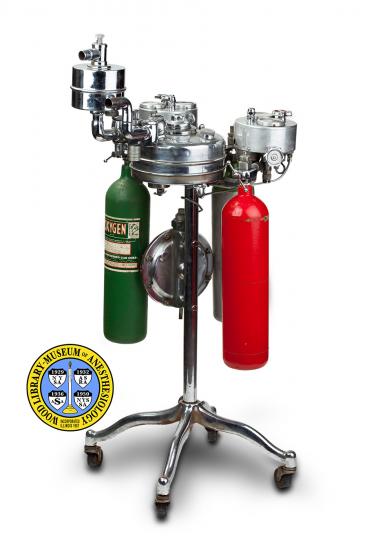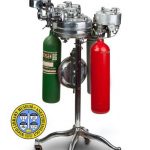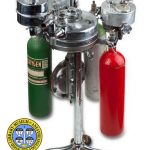Ben Morgan Machine
Dr. Ben Morgan (1883-1974) was born in Oregon, and graduated from the Chicago College of Medicine and Surgery in 1914. The same year, he served as a medical officer in the German army, where he made the first model of his ether insufflation apparatus. When World War I broke out, he managed to cross the border into France, and briefly served as a French medical officer. He was then sent to England, where again he briefly served as a medical officer, returning to the U. S. before this country's entry into the war.
Dr. Morgan spent the rest of his career in Chicago, where his machines were manufactured for over thirty years. He described his first apparatus in 1915, and patented it in 1916. That apparatus prevented rebreathing of exhaled carbon dioxide, a practice that he said "should be abandoned." But his next model was a nitrous oxide, oxygen and ether machine that incorporated a rebreathing valve. The later design shown here adds ethylene gas, and has a carbon dioxide absorber. In most machines of that era, the ether vaporizer is a glass jar attachment. The Morgan vaporizer is a metal cylinder at the center of the apparatus.
Catalog Record: Ben Morgan Machine Ben Morgan Machine
Access Key: akxn
Accession No.: 1964-02-28-1 A
Title: The Ben Morgan apparatus.
Corporate Author: Ben Morgan.
Title variation: Alt Title
Title: Ben Morgan machine.
Publisher: Chicago, ILL: Ben Morgan, [between 1925 and 1945?].
Physical Description: 1 anesthesia machine : metals, glass, plastics, rubber ; 108.5 x 57 x 60 cm.
Subject: Anesthesia Machines.
Subject: Ethylene.
Subject: Nitrous Oxide.
Subject: Oxygen.
Subject: Ether, Ethyl.
Subject: Morgan, Ben, 1883-1974.
Subject: Carbon Dioxide Absorbers.
Web Link: http://woodlibrarymuseum.org/museum/item/737/ben-morgan-machine
Note Type: General
Notes: The early year in the date range is a rough estimate based on the year that ethylene was introduced into clinical anesthesia (1923). The end date is an estimate based on a number of items – One tag found on this machine reads, “St. Mary of Nazareth Hospital Chicago, Ill., Feb. 28, 1964. Text on another tag, older and in poor condition, found on this machine, includes, “Flinders Road, April 11, 1945, New York Branch”. Handwritten in pencil on this tag is, “Pau M. Wood, 17990”. Also, a number of authors report that, after its introduction in the early 1930s, cyclopropane largely replaced ethylene in clinical anesthesia. (Jacob AK, Knoop SL, Bacon DR, Smith HM, 2013 ; Jones R, 2014 ; Sixty-six years ago in Anesthesia & Analgesia, 1989). The date range could change if documentation indicates that it should be corrected.
Note Type: Citation
Notes: Jacob AK, Kopp SL, Bacon DR, Smith HM. The history of anesthesia. In: Barash PG, Cullen BF, Stoelting RK, Cahalan MK, Stock MC, Ortega R, eds. Clinical Anesthesia. 7th ed. Philadelphia: Wolters Kluwer/Lippincott Williams and Wilkins; 2013:13. [Page 13, “When cyclopropane was introduced, ethylene was abandoned..”].
Note Type: Citation
Notes: Jones R. A history of inhaled anesthetics. :In: Eger EI II, Saidman LJ, Westhorpe RN, eds. The Wondrous Story of Anesthesia. New York: Springer; 2014:616-617.
Note Type: Citation
Notes: Morgan B. Practical anesthesia, showing a new ether apparatus. Am J Surg. July, 1916;30(7)(suppl):95. https://archive.org/details/americanjournalo30newyuoft. Accessed September 10, 2014.
Note Type: Citation
Notes: Morgan J. The Dangers of Chloroform and the Safety and Efficiency of Ether. London: Bailliere, Tindall, and Cox; 1872:44-48. http://books.google.com/books?id=pRkDAAAAQAAJ&printsec=frontcover#v=onepage&q&f=false. Accessed September 10, 2014.
Note Type: Citation
Notes: Sixty-six years ago in Anesthesia & Analgesia. Anesth Analg. 1989;68(3):405. http://journals.lww.com/anesthesia-analgesia/Citation/1989/03000/Sixty_Six_Years_Ago_In__Anesthesia___Analgesia_.44.aspx. Accessed September 2, 2014.
Note Type: Physical Description
Notes: One chrome plated anesthesia machine; It has a short but broad cylindrical mixing-regulating-vaporizing chamber, on top of a pole with four legs and wheels, three yokes for gas cylinders, two cylindrical gas flow control chambers, and a breathing circuit extension; Below the mixing-regulating-vaporizing chamber, attached to the pole is a gas-pressure regulator; Most of the chrome plating is in relatively good condition with some scratches and spots of corrosion; The underside of the pieces and other unplated areas have light corrosion; The measurements in the physical description field were taken treating the breathing circuit extension as the front of the machine; The cylindrical mixing-regulating-vaporizing chamber measures approximately 18 x 21.54 x 21.5 cm; On the top of the mixing chamber is a dial with a single handle on one end and a pointer on the other; The dial can turn to positions from “OFF” to “STRONG”; The markings and positions starting after OFF include, “THE BEN MORGAN [new line] APPARATUS”, and “AIR”; After AIR there are 7 increments followed by “MEDIUM”; A curve runs from the lower part of air to the upper part of medium; Above the curve the space between the increments is chrome in color and is marked, “DILUTION OF”; Below the curve the space between the increments is black and is marked, “ETHER VAPOR”; A valve to the left of the dial is marked with a 0, 1, 2 and 3, as well as “BEN MORGAN [new line] PAT. PENDING”; A thin metal hose runs from this dial to behind the mixing chamber where the gases from the two gas flow control chambers seem to meet; An inlet cap to the right of the mixing chamber dial is also marked, “BEN MORGAN [new line] PAT. PENDING”; The gas flow control chamber on the left is cylindrical with two circular gauges and a fluted turn knob; The turn knob is green and marked “LOW PRESSURE”; One of the gauges is marked “OXYGEN” and has a scale with increments of 1, which are numbered from 0 to 50 in increments of 5; Also marked on the face of this gauge is “BEN MORGAN [new line] CHICAGO, U.S.A.”; The other gauge has multiple scales; The inner most scale is red and marked, “PERCENT FULL AT 70F°”; This innermost scale is red and marked in increments of 10 from 10 to 100; The outer scale is black and marked in increments of 300 from 0 to 3000; The gas flow control chamber on the right is cylindrical with two round gauges and a fluted turn knob; The turn knob is red and marked “LOW PRESSURE”; One of the gauges is marked “ETHYLENE N2O” and has a scale with increments of 1, which are numbered from 0 to 50 in increments of 5; Also marked on the face of this gauge is “BEN MORGAN [new line] CHICAGO, U.S.A.”; The cover of the other gauge is stained or burned and cracked and most of the gauge below it is very difficult to read; Both of the gas flow control chambers measure approximately 17 x 16.5 x 14 cm; The breathing circuit that extends off of the mixing chamber divides to a carbon dioxide absorber on the left and a curved metal tube for inspiratory tubing on the right; Between the two sides of the breathing circuit is a dial in which a pointer can turn to point at ON, 1, 2,3, or OFF; A patent number that applies only to the gas-pressure regulator is embossed on the regulator, “PAT. NO. 1630408”; The legs of the pole all have wheels; The wheels do not turn well and the machine needs to be lifted to move it.
Note Type: Reproduction
Notes: Photographed by Mr. Steve Donisch, September 23, 2013.
Note Type: Acquisition
Notes: Donated to the WLM by St. Mary of Nazareth Hospital, Chicago.
Note Type: Historical
Notes: Dr. Ben Morgan (1883-1974) was born in Oregon, and graduated from the Chicago College of Medicine and Surgery in 1914. The same year, he served as a medical officer in the German army, where he made the first model of his ether insufflation apparatus. When World War I broke out, he managed to cross the border into France, and briefly served as a French medical officer. He was then sent to England, where again he briefly served as a medical officer, returning to the U. S. before this country’s entry into the war.
Dr. Morgan spent the rest of his career in Chicago, where his machines were manufactured for over thirty years. He described his first apparatus in 1915, and patented it in 1916. That apparatus prevented rebreathing of exhaled carbon dioxide, a practice that he said “should be abandoned.” But his next model was a nitrous oxide, oxygen and ether machine that incorporated a rebreathing valve. The later design shown here adds ethylene gas, and has a carbon dioxide absorber. In most machines of that era, the ether vaporizer is a glass jar attachment. The Morgan vaporizer is a metal cylinder at the center of the apparatus.
Note Type: Publication
Notes: Morgan B. Anesthetist’s notebook. Hospital Management. January, 1937;56:51-54.
Note Type: Publication
Notes: Chicago Anesthetic Equipment Co. [advertisement]. In: Directory of Members. Chicago, Illinois: American Society of Anesthesiologists; July, 1949:6. [Text at the bottom of this advertisement includes ” … formerly Ben Morgan Apparatus Co.”]
Note Type: Publication
Notes: Morgan B. Anesthetist’s notebook. Hospital Management. May, 1937;56:435.
Note Type: Publication
Notes: Morgan B. Scientific anesthesia. Hospital Management. August, 1937;57:442.
Note Type: Exhibition
Notes: Selected for the WLM website.



